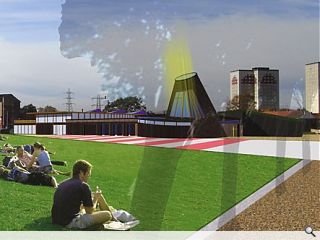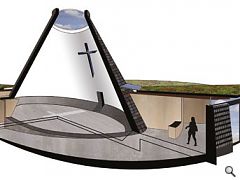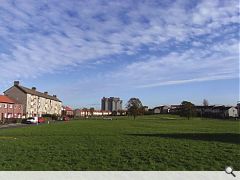Waste not want not
14 Jan 2010
With the private sector in the doldrums and an indebted public sector braced for swingeing cuts who is going to fill the economic breach? Who can tap into the "drive" so often absent from state driven diktat in areas where the private sector fears to tread?
In many ways Milton is something of a time warp with its poverty keeping the detritus of prosperity Ð executive homes, business parks and retail sheds at bay more effectively than legislation ever could. The limit of the city's urban extent is marked by a canal, a row of six tower blocks and thenÉ fields. It is one of the most dramatic urban boundaries in the city and makes for a surreal sight, particularly with many post war tenements being demolished and replaced withÉ nothing.Ê Effectively this is the high water mark of a city in retreat.
It is into this landscape that Colston Milton Parish Church and the local community plan a project of greater audacity than many of the big budget extravagances in the city centre: a community space, activity hall and place of worship, constructed from nothing but recycled materials and built, largely, from local labour.
The scheme was initially sparked by the decision of the church to sell off land and their main worship space for flats, leaving just a hall which the organisation had to share with the boy's brigade and several community groups.Ê ThisÊalone was costing £10k a year to heat and power, prompting the minister, Rev Christopher Rowe, to stipulate any new building be self sustainable in its energy use and be built by local people under ownership of the community.
Rowe brought onboardÊarchitect Lee Ivett, of Baxendale Design Co. Ltd, who described a faltering start with wild rumours circulating through the community that a drug rehabilitation centre was planned and with several locals up in arms about having any development near their homes. Tackling the rumour mill head on Ivett took time out to go door to door with a model of his plans: "There was no local council and a history of apathy with things not getting done so we set out with a consultation to establish what the community needed. What I found was a new generation of people who were keen on making a difference and this project has given people ways of doing that."
It is an approach necessitated by the need to nurture the seed of an idea that someone has and plant it in a way that the community has an opportunity to take ownership. Ivett explains: "It isn't a token thing; literally anyone can join this organisation and own the project.Ê It's not like the Council has built a new resource and residents are involved because they were consulted, or planted some trees or have a membership cardÉ people were genuinely integral to the process.
"We looked at what the need was for the project, we didn't say what do you want? We asked what do you like/hate about where you live and got to the root causes of people's positive or negative perceptions because what people want is a swimming pool or a Tesco and that isn't necessarily what can be delivered. It's about informing the community about what they can achieve, the level that they can achieve, off their own back and how that can start meeting some of the particular needs of that area." To effect this the Love Milton brand was developed, which is now a company ltd by guarantee and applying for charitable status. Ivett recalls: "Forming a group of people with no track record and seeing people progress through steering groups to a proper constituted committee and on to form a companyÉ that is a model for regenerating communities."
The church identified a location right in the heart of the area with the worst anti social behaviour and crime rate, a move that proved surprisingly reassuring for Ivett who welcomes this brave embrace of adversity. "When I first met the minister he said we need a new worship space, a hall and a new community centre as the old one was closing and the new centre being built as part of a school didn't have a stage in it.Ê But the scale of the building started to grow after we identified the requirements of a local youth group operating in a couple of portacabins. Now all parties are trying to deliver solutions for everyone whilst also making money by renting out space in the process.
"Landscape architects have been brought on board to look at the wider public realm to avoid creating a walled compound but rather a building within an urban park. This means existing pedestrian routes on the site can be maintained such that every elevation is supervised passively."Milton's flock numbers only around 50 so Ivett was keen to avoid building something vast in plan; instead a sense of scale was developed through height and volume. In addition the congregation was looking to move away from a hierarchical layout of pews toward something that was more inclusive with the minister in the centre of a semi circle. This dictation of plan led to the natural adoption of an ellipse shaped tepee like structure, topped by a central south facing aperture that focuses light down upon the sermon.
This sense of drama is accentuated by sinking the sanctuary space 1.5m below ground level so people have to descend a processional ramp to reach the central chamber. The idea behind this is to build a sense of anticipation, gradation and theatre, rather than merely opening a door and being hit by the space.Ê Ivett revealed: "All the different groups wanted to feel that they were part of something together but at the same time I was keen that this side of things feels quite special."
In form there is no consistency between the constituent parts of the scheme, an approach Ivett admits veers from architectural orthodoxy but then as a project the entire concept is very far from orthodox.Ê "Generally there's a desire, because you've been taught it, to keep a consistent architectural language all the way through. There isn't a consistency in architectural language here but there's a consistency of materials, we're using timber cladding reclaimed pallets, tiles and corrugated metal and in some form each of those three types appear on each elevation.
"But the form of each element I wanted to respond very specifically to the need of its function so the language of the church is contemporary but representative of spiritual needs, whilst the theatre and activity hall are driven by the work within."
Shipping containers define internal space within whilst a green roof punctuated by photovoltaic cells, complemented by wind power and/or biomass, will provide half of all power in the building. Ground source heat pumps, essentially a tube inserted one metre into the earth, will draw upon the inherent warmth found there to create a decent ambient temperature.
"There may be a design where the local input of volunteers might be more hands on than simply bolting some things together and we're looking at what that involvement would be. We've got a glulam timber structural frame with straw bail infilled walls and are using rammed earth car tyres for the gables. This, along with painting, lining and fitting out the containers, are all things that most people can get involved with.
"We can't have a situation where we're just inviting people to turn up on a weekend and knock something together. We have to develop a process that is professional, rigorous. We looked at whether we could contract it out, put it to tender, get a specialist eco builder in or set up our own company to do it as a social enterprise. By developing the skills and management techniques with this building people can go on and build their own houses or that experience can be sold to other groups. Over 5, 10, 15 years a vehicle and organisation could be established with the wherewithal to improve the community in whichever way they saw fit.
"The idea is they would set up a company to manage and deliver this project, they would hire a project coordinator, a construction manager and that core group of professional people would bring in the relevant training partners, skilled and unskilled labour. It is silly to assume that this will all be done by volunteers. Plumbing, electrics, structural frame all have to be delivered by specialist subcontractors. We've been very specific about which elements can be delivered by work experience programmes and the unemployed.
"Local people who come together for this haven't done anything like this before and that isn't a bad thing because what they're doing is so unique through all our naivety and inexperience the ambition behind the project is high.Ê It's nice to have a group of people who believe we can do this; the only thing stopping us is money. The Scottish Climate Challenge fund financed the feasibility study and we'll be returning to them for further funding but the group will need to find the money for this themselves." Even in the current financial climate raising a couple of million for a building project isn't insurmountable. Ordinarily a project of this magnitude would cost in the region of £4m but this has been halved by sourcing reclaimed materials and voluntary labour to reduce costs from just under £3m to £1m with renewables, landscaping and fees forming the remainder.
"It's a high value scheme with a low comparative cost so hopefully money can be raised and the project delivered.Ê It can be built in phases so if we generate the first £750k we can move onto the first stage. Part of the feasibility study was putting together a business plan which indicates that this will work. That's why we've got space in there to let."
GCC have granted a development hold on the site in favour of Love Milton, giving the company until March 2011 to develop their proposals further and also transfer ownership. This means the land cannot be sold to anyone over the next year, ensuring the site remains free for development until funding is found.
Before a beer can has even been laid though the scheme is reaping positive spin offs for the Milton area with a documentary in the making alongside copious column inches a dramatic shift for a locale more used to reading about the lowest this or highest percentile that for health and crime. Perhaps the real legacy being built here isn't architectural but societal.
|
|
Read next: Police Estate
Read previous: Hard lessons
Back to January 2010
Browse Features Archive
Search
News
For more news from the industry visit our News section.
Features & Reports
For more information from the industry visit our Features & Reports section.





